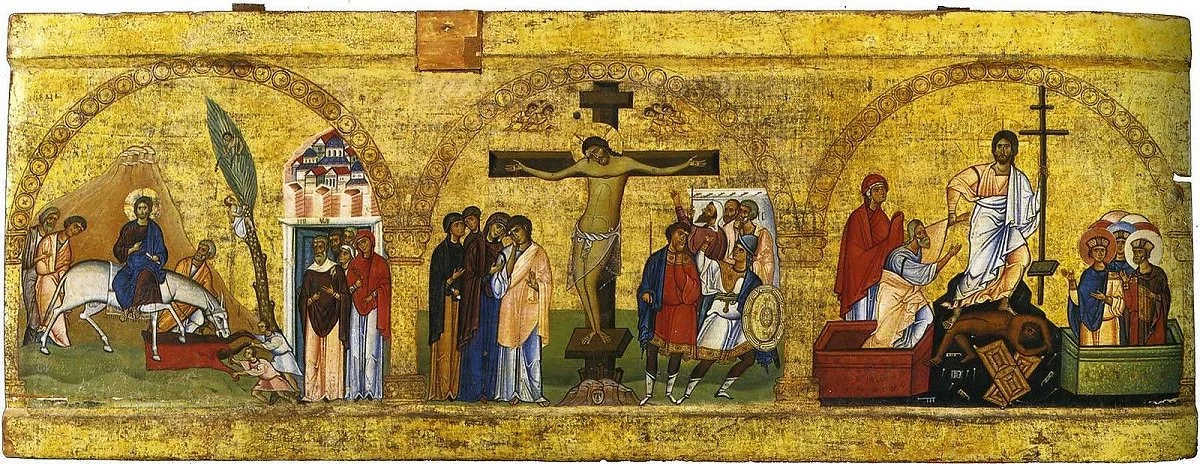by Fr Gabriel-Allan Boyd
This Sunday marks the crux of Lent…the midpoint of these 40 days. Here, our mother, the Church, offers to us The Cross to meditate upon, “to strengthen and refresh us.” But, a cross is a strange symbol from which to gain such reinforcement. Why would we believe that this implement of death could so strengthen us? Is there more to this symbol of the cross than we may realize?
Here, it’s helpful to remember that our earliest Church Fathers only had the Old Testament for their bible. And within its chronicles they saw a rich treasury of God-given metaphor…word-pictures…icon-stories of the struggles we currently endure, and the ways God offers His loving grace to heal us of the very things that distance us from Him.
Typically, by this point in Lent, the great struggles of fasting, additional prayer/liturgy, and almsgiving are like having just gone to a gym for a tiring workout, and we feel more exhausted than strengthened. Those asceticisms are meant to be our way of crucifying our own self-absorbed desires—or what the Church calls, “our passions”—in order to strengthen our unity with God’s loving desires. But at this point, our wobbly spiritual bodies may feel more like spiritual spaghetti after such a workout. We may have discovered that we’re less unified with our Lord than we previously thought. And so, we may taste a bit of bitterness in these spiritual waters we’re drinking. Bitterness describes our condition when we discover we’ve grown apart from the grace of Christ.
So, the early Church Fathers took inspiration for this part of Lent from the story in Exodus 15:22-27.
There, God has just rescued the Israelites from Egyptian slavery…and the Egyptian army who had been in hot pursuit to kill them has just been swallowed up by the Red Sea. What a marvelous triumph it was! What a great thrill it was to celebrate afterward, and to worshipfully sing, “Who is so great a god as our God. You alone are the God who works wonders!” From that scene of great celebration (just as we celebrated the Triumph of Orthodoxy last Sunday), Moses has now led his thousands of Israelite followers on into the hot desert, where they’ve walked for three days without finding any water. Imagine the sense of panic that must’ve been welling up inside them. Something doesn’t feel right. How could they go from such elation of Godly triumph to such struggle and suffering? How could a loving God expect them to endure so much? They had all become quite thirsty. Parents were worried for the sake of their children. Imagine the fatigue that they must’ve felt at this point.
Finally, they come to a place where there’s water, but when they taste it, they discover that it’s
so bitterly repulsive, that even in their extreme state of thirst, they simply can’t drink it. It’s just too bitter for them to endure. Unfortunately, the Israelites did what most any of us would very likely do…they complained to and grumbled against their leader, Moses. So, Moses cried out
to the Lord on behalf of His people, and the Lord provided a solution. God gave Moses instruction about a certain tree, which when cast into the midst of the water, would transform it. When Moses did that, the water became mystically drinkable. But, the bitter waters of this place revealed the bitterness that lodged in the hearts of the Israelites. Notice the contrast between the two…that the people grumbled against Moses…while Moses cried out to the Lord. The external obstacle revealed the internal realities of their hearts. Moses trusted the Lord and cried the problem out to Him. The Israelites, on the other hand, betray a lack of trust in God as they grumble amongst themselves against Moses. What becomes evident in the face of this bitter situation is that the Israelites need deliverance from more than just Pharaoh. They need deliverance from their own grumbling, mumbling, bitter faithless selves. And our Lord set to bring about that deliverance in them…and in us. The Lord instructs Moses and us regarding a certain tree of transformation.
As we journey with God, following where He leads, we sometimes find that He’s actually led us into the midst of some terribly bitter situation and into a time where our faith is being tested, where we discover just how little we trust that He knows what He’s doing…and we also discover how little we trust that God loves us in spite of what we may be suffering at the time. When we cry out our bitter situations to God, He’s able to alter them…that is, to make them drinkable, to turn them into a resource for the next leg of the journey. God can be trusted to redeem, and even transform whatever problems we might face so that it becomes something that’s for our good. He tells the Israelites and us that “If you listen carefully to the Lord your God and do what is right in His eyes, if you pay attention to His commands and keep all His decrees, you’ll receive His healing.” Our Lord heals those who hear His voice and obey Him.
So, at this halfway mark within Lent, the Cross of our Lord (that Tree) reminds us of the bitterness of what He endured, and how it was transformed for His and all of our sakes. God the Father didn’t take the Cross away, so that His Son wouldn’t have to endure such suffering, but rather, He made that bitter cup drinkable for our Lord. It makes us mindful of the fact that our Lord was willing to faithfully endure so much for our sakes…therefore what are we willing to struggle with for His sake. It reminds us of the glory that came through His cross and of the hope that comes to us when we take up our own cross, willing to suffer our own unpleasantness for a time…until He leads us to the Promised Land of resurrection in Him. But there is no resurrection without first going through the Cross.
Not only is the cross that tree which was thrown into the midst of the bitter waters to make them drinkable, but as the Synaxarion of this Sunday says, “the Holy Cross is also called the tree of life, and this tree has been planted in the center of Paradise, in the same way the Holy Fathers have planted the tree of the Cross in the center of the Great Lent so we can eat from it and live forever.”
Not only has the Cross been placed at the center of Great Lent, but the Church has also given it a very central role in our daily life. We make the sign of the Cross upon ourselves in the name of the Holy Trinity every time we pray, enter the Church, venerate an icon or participate in the Holy Liturgy. In everything we do we take the Cross upon our lives for our salvation, reminding us that only through living the way of the cross will we find the way to Paradise in Christ.
It’s important to remember that in most of Orthodox portrayals of the crucifixion, we don’t highlight our Lord’s suffering and despair, as you see in western depictions of it. Instead, Orthodox icons of the Crucifixion typically show Christ standing on the cross, almost supporting it, not so much hanging from it. Even though, it’s true, Christ did suffer on the Cross, the image doesn’t lose its peace…because our Lord willingly took on the Cross for us, knowing that the Resurrection would follow. Therefore, amidst the bitter waters of crucifying our passions, the Cross radiates peace and hope. “Come, all faithful, let us venerate the holy resurrection of Christ. For behold, through the cross joy has come into all the world. Blessing the Lord always, let us praise His resurrection. For in enduring the cross for us, He destroyed death by death.” Amen.


